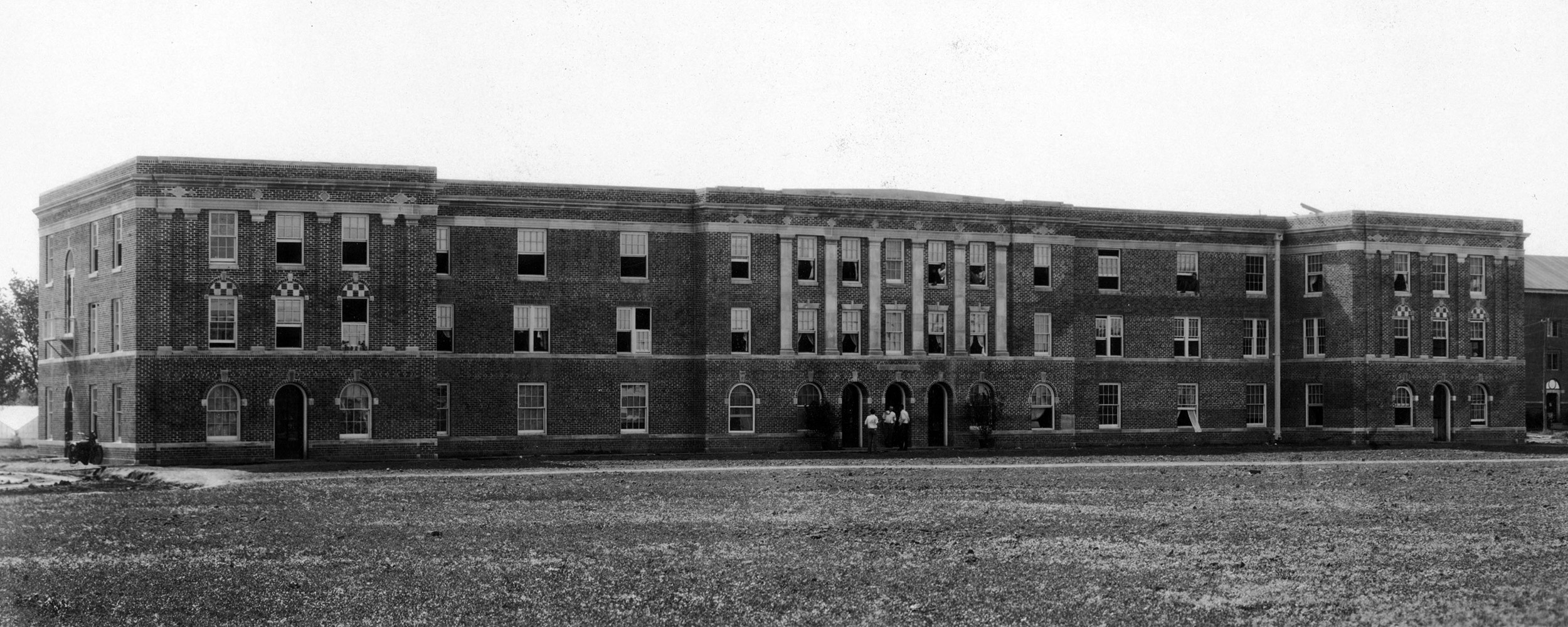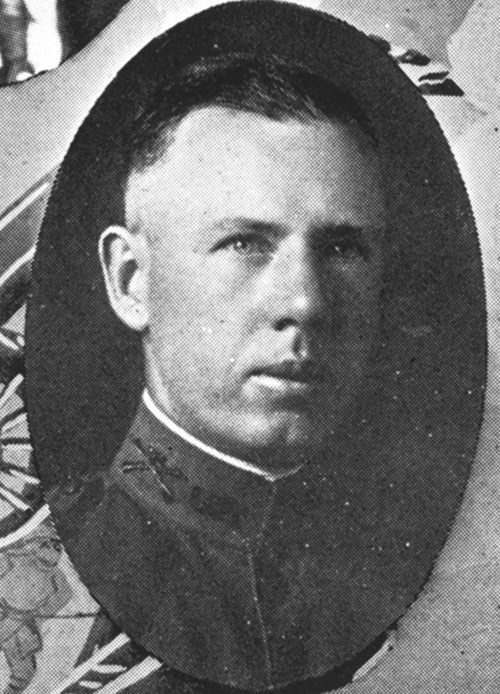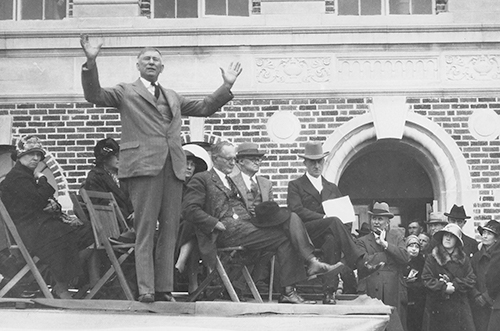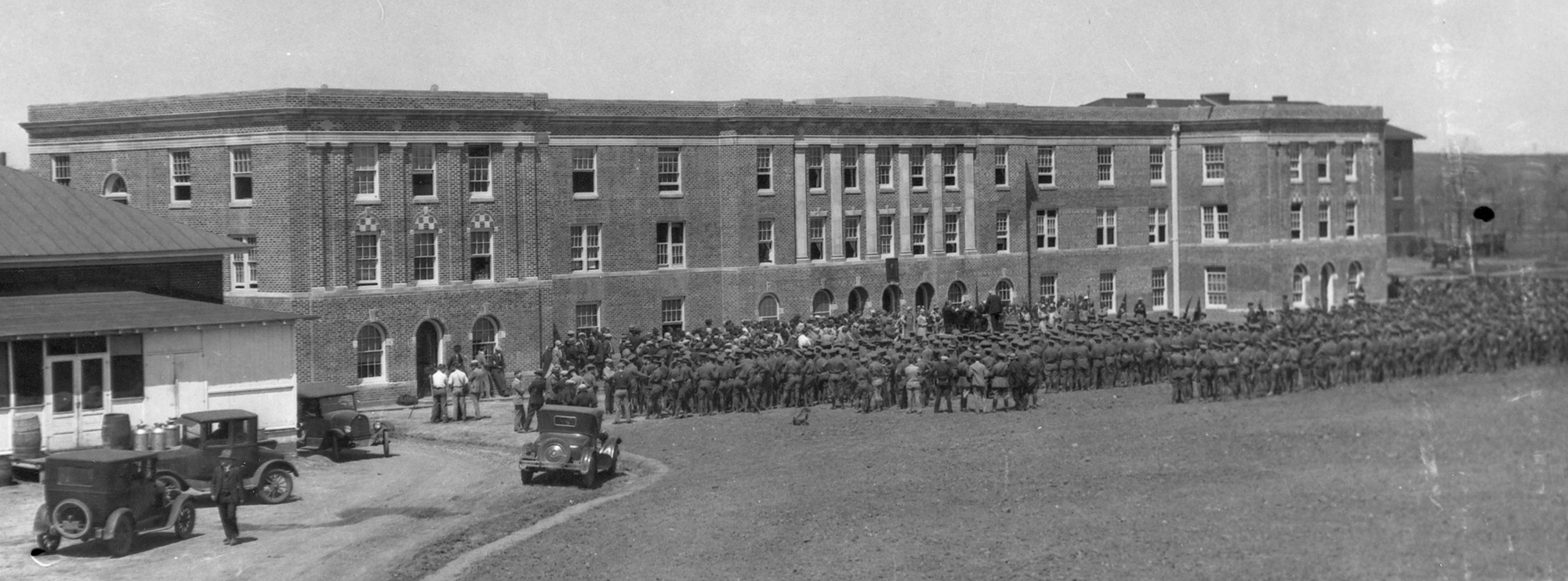
Captain Carter Hanner and the history of Hanner Hall
Wednesday, February 3, 2021
Carter C. Hanner (1878-1918)
 Carter Cary Hanner was born on June 4, 1878, in Donnellson, Montgomery County, Illinois
to Harrison and Samira (Bigham) Hanner. Harrison and Samira would have three daughters
and two sons. The Hanner family moved to Oklahoma Territory in 1893 and settled in
Stillwater. Carter enrolled at Oklahoma Agricultural and Mechanical College in the
fall of 1897, but left to serve in the Spanish American War beginning in 1898. In
The Philippines, Hanner served in Company D, 33rd Infantry. Returning to Stillwater
from The Philippines after 18 months of service he went into business as a partner
and co-owner with John L. Bishop where they opened a clothing store on Main Street
in downtown. He remained in the National Guard serving as a lieutenant in Company
I located in Stillwater.
Carter Cary Hanner was born on June 4, 1878, in Donnellson, Montgomery County, Illinois
to Harrison and Samira (Bigham) Hanner. Harrison and Samira would have three daughters
and two sons. The Hanner family moved to Oklahoma Territory in 1893 and settled in
Stillwater. Carter enrolled at Oklahoma Agricultural and Mechanical College in the
fall of 1897, but left to serve in the Spanish American War beginning in 1898. In
The Philippines, Hanner served in Company D, 33rd Infantry. Returning to Stillwater
from The Philippines after 18 months of service he went into business as a partner
and co-owner with John L. Bishop where they opened a clothing store on Main Street
in downtown. He remained in the National Guard serving as a lieutenant in Company
I located in Stillwater.
On May 26, 1908, he married Zella Lytton at her mother’s home with the Rev. Virtes Williams officiating the wedding. Carter and Zella raised three children: Wilma, Alan, and John. Beginning in 1916 Lieutenant Hanner helped protect the United States and Mexican border as Major General John Pershing pursued Pancho Villa. Within one month of returning home after serving in the National Guard, Lieutenant Hanner re-entered military service on April 5, 1917, for training. For several months he stayed at Fort Sill before being stationed at Camp Bowie, Texas. At Camp Bowie he was a gas mask instruction training officer. His regiment went to France on July 4, 1918, where he joined the American Expeditionary Force. Assigned to Company E, 142nd Infantry, 36th Division he was promoted to Captain on Sept. 6. Company E was assigned to the Meuse-Argonne front for the final major military offensive of World War I against the Germans.
While engaged in heavy combat near the village of St. Etienne-a-Arnes, Carter was wounded on Oct. 8, 1918. Orlo Lowry, a friend of Carter’s from Stillwater, described what happened in a letter sent back home.
As soon as I received your letter telling me of Captain Carter Hanner’s death I drove up to his division which is very near us in hopes of finding a mistake had been made, but found he had been killed as reported. He commanded Company E, 2nd Battalion, 142nd Infantry, 36th Division which went in to line on our left in the Champagne country near Suippes. They relieved our fighting 2nd Division, which shows what was thought of them as a fighting unit. They were under a French corps and went over the top on the morning of October 8th under as simple a field order as was ever given in the war, the kind they give a crack division. It merely read: The barrage will be lifted at 3 a.m. and you will drive the enemy back to the Arnes. This meant an advance of some fourteen miles, but the 36th proved equal to the task. They were in the line twenty-three days and Carter’s regiment was in at the jump-off and stayed until the finish. His battalion went in with seventeen officers and came out with two both injured. Carter’s company was one of the two chosen to launch the attack against a stronghold the enemy had been holding stubbornly for days against our repeated attacks. He was wounded in the thigh by machine gun fire at the jump-off, but refused to quit and fell at the head of his men two hours later shot through the abdomen and body. He was carried into a dugout still conscience and ordering his men to leave him and resume the attack.
Stretcher-bearers found Captain Hanner three hours later as he died on Oct. 9. His burial took place at the Meuse-Argonne American Cemetery near Romagne. News of his death reached his family just weeks before the Armistice on Nov. 11, 1918. A telegram from the War Department to John Bishop confirmed the news. The 36th Division suffered 466 combat deaths and 2,118 wounded in action during World War I. Lowry’s letter continued:
Carter was one of the most popular officers in the division and although he had had command of his company but a short time, his men fairly worshipped him. It seems hard that we should lose a friend so dear to us in the last few days of the war but every soldier cannot but envy him in death. He went gloriously down leading his men to a victory, which contributed in no small way to the peace the world can thus enjoy and his loved ones, friends, the community, and America can well be proud of having furnished a good and brave soldier.
Captain Carter C. Hanner received the French Croix de Guerre decoration for gallantry in action.
Hanner Residence Hall
In the early 1920s, the Oklahoma Agricultural and Mechanical College was in desperate need of more residential housing. Hanner Hall and its twin sister Thatcher Hall would be completed late in 1925 to address the demands of an increasing student population. Prior to construction, many male students had been housed in the remodeled Stock Pavilion and some even resided in rooms located in barns at the Experiment Station Farm. The two new residence halls were the first dormitories on campus financed through bonds authorized through the Oklahoma Legislature and State Board of Agriculture. Together both buildings would receive a revenue stream of $300,000 from bonds dated Sept. 15, 1924, and paid out for 25 years at five percent interest. Student rent was used to repay the bonds.


Captain Hanner’s commanding officer and friend Brigadier General Roy Hoffman (left) and John A. Whitehurst (right), president of the Oklahoma Board of Agriculture, were two of the speakers at the dedication of Hanner Hall on April 16, 1926.
Contracts were awarded to the Kreipke-Schaefer Construction firm from Oklahoma City in June of 1925 and they were allowed 145 days to complete construction, the goal to provide student housing by January of 1926. The original proposal called for five story buildings with large wings at each end that were four stories. But available revenue and construction costs reduced the structure to only three stories with much smaller wings. Each included a small basement designed for residents to store their travel trunks and provide utilities access. Both front-facing sides had architectural design details with ornamental touches, the remaining sides were very plain. Each structure was 200 feet north to south and 50 feet wide at the wings. They would face each other on the new quadrangle formed north of Morrill Hall, south of the Gymnasium and serve as a mirror images.
Thatcher Hall, designated for women, would be constructed just north of the existing Women’s Building and Hanner Hall, for men, built close to Crutchfield Hall, the only existing men’s dormitory. Most rooms would be 12 feet-by-14 feet. Every room had at least one window, electrical plugs for fans, and a sink. The rooms were fitted with two spring-assisted Murphy beds that could be folded up during the day. A study desk with book racks at either end and two chairs were located in the rooms and there was storage space in the small closet with a small dresser. Both men and women had white medicine chests with mirrors located above the sinks. There were separate bath and toilet areas designated on each floor. Both residence halls had two parlors and a reception area on their first floors with the remaining space designated for dormitory rooms.
Hanner Hall would have 79 rooms with a total occupancy of 162 students charged a monthly rent of seven dollars per resident. Each hall had a resident matron or hostess and for the first time a woman was assigned to a men’s residence hall. Harriett McNabb served as the Hanner Hall hostess from January 1, 1926 until her retirement on Sept. 1, 1942.
The new men’s and women’s residence halls were open and available for student occupants in January of 1926.
Dedication of the Hanner Hall residence for men occurred on April 16, 1926. Earlier in the day many had traveled to downtown Stillwater for the dedication of the Stillwater American Legion Hall, also named in Carter Hanner’s honor. At 9:30 a.m. the OAMC Corps of Cadets with the college band marched from campus to Main Street for the dedication of the legion hall. State, Stillwater, and local legion dignitaries attended and provided remarks.
Those assembled then traveled to the OAMC campus to join others gathered at the newly completed residence halls. President Bradford Knapp served as the Master of Ceremonies and he said that the men’s residence hall was being named after a “distinguished soldier, fine character, noble man, Carter C. Hanner.” The president of the Oklahoma Board of Agriculture, John A. Whitehurst, then spoke followed by Robert Kerr. Kerr referred to the new residence hall as a home for men, many of which served their country in Europe and had desired to return home. He said, “A man’s heart commands no deeper sentiment than the love for his home.” National Adjutant of the Legion, James R. Barton, also attended and spoke.
Captain Hanner’s commanding officer and friend Brigadier General Roy Hoffman described him as “one of the best citizens, soldiers, fathers, and friends I ever knew. There is not, was not, cannot be a nobler man than my dead comrade Carter C. Hanner.” Hanner’s wife and surviving children attended. His daughter, Wilma, lifted the veil covering the bronze plaque honoring her father and providing details of his life. Those assembled then moved to Thatcher Hall for women and the final dedication of the day. Thatcher Hall was named for Jessie Thatcher Bost, the first woman graduate of Oklahoma A&M College, a member of the Class of 1897.
During World War II, the Air Force and Army training programs used Hanner Hall as a home for their cadets while on campus. Taken off line as a residence hall in 1968, Hanner Hall was reassigned for general university use. It would eventually be used as a temporary residence hall for a sorority waiting on completion of their new chapter house, a home for the campus Financial Aid Department, and offices for the College of Business. It was torn down prior to the construction of the new Business Building, dedicated on the site in April of 2018.
The dedication of Hanner Hall on April 16, 1926 saw hundreds of people gather outside the building to hear from OSU President Bradford Knapp and other dignitaries.

